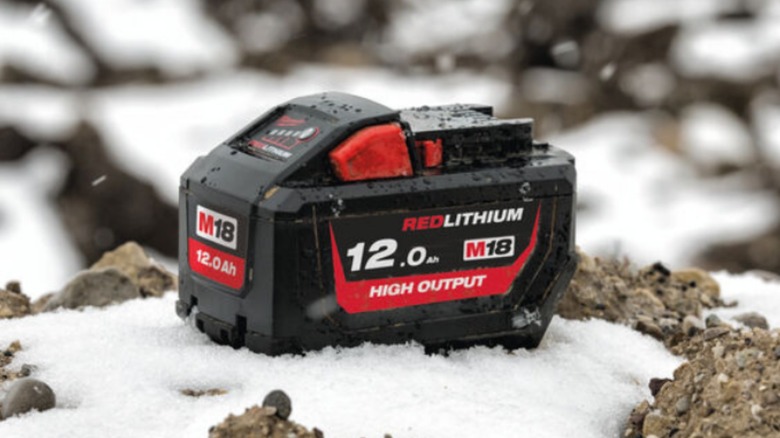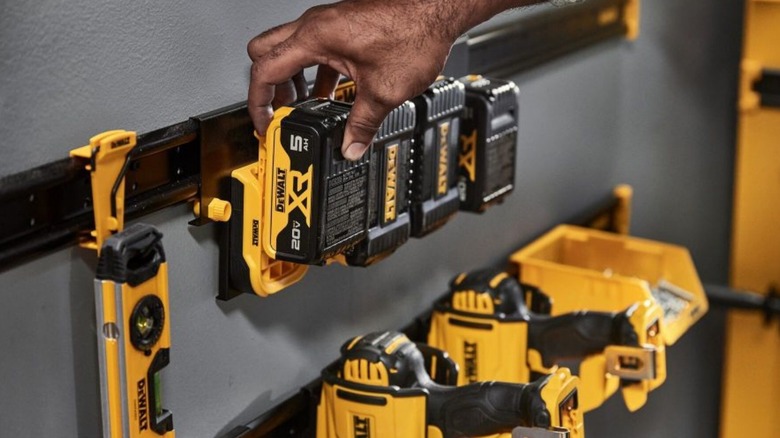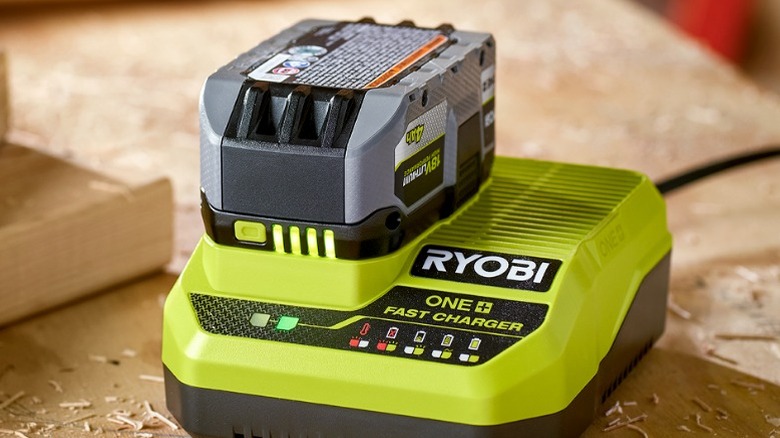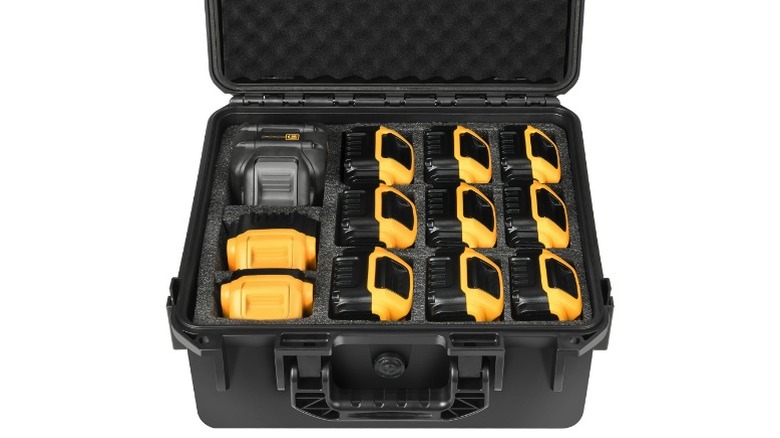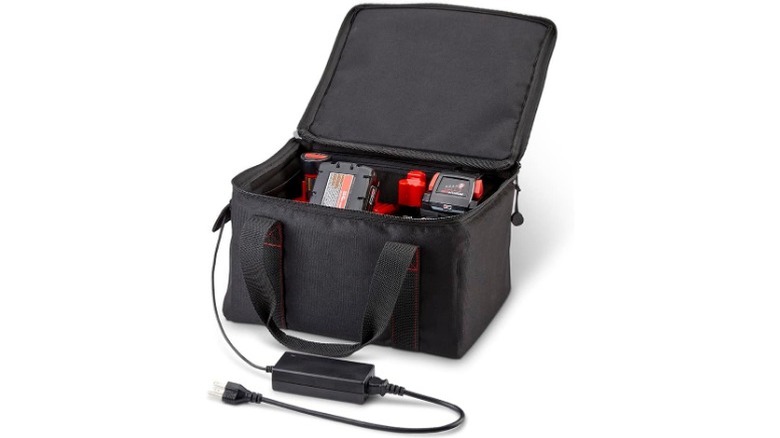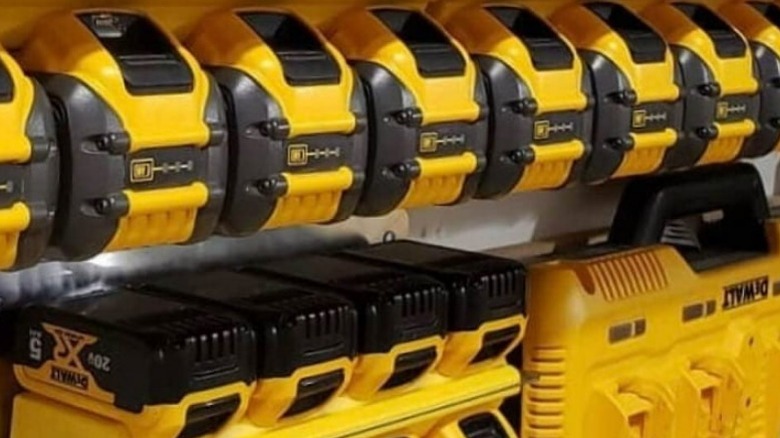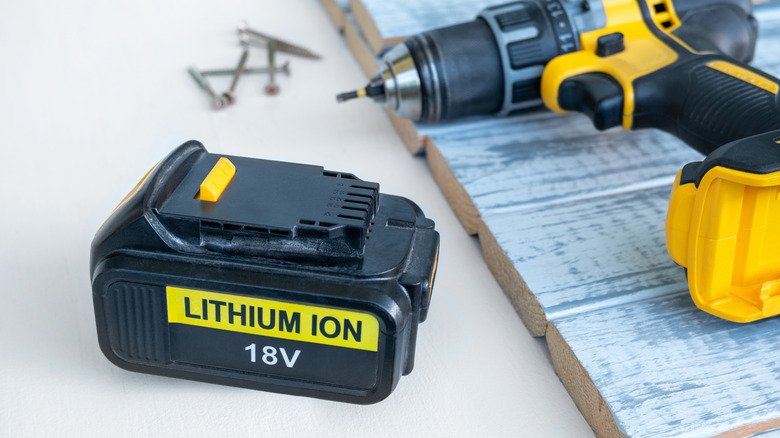How To Keep Power Tool Batteries Safe Over Winter (And What To Avoid)
We may receive a commission on purchases made from links.
Most modern power tools use lithium-ion batteries. There's a whole host of reasons why these became the industry standard. They're much more efficient than the old Nickel Cadmium batteries. They charge faster, can hold a higher capacity of electricity, and can maintain that capacity for longer, even when they aren't in use. That means you can spend more time with the battery in your tool and less time waiting for it on the charger. They also weigh less, making the tools they power much more maneuverable.
That said, they aren't perfect. There are two major downsides to using lithium-ion. The first is that it's more expensive, and the second is that its overall lifespan is shorter. A lithium-ion battery usually only lasts two to three years before it starts to degrade, with the battery's overall capacity shrinking over time. Then, before you know it, the battery will start to exhibit telltale signs that it needs to be replaced.
Certain environmental factors can accelerate this process. That's why it's important to store your batteries properly. Good storage habits are important to maintain year-round, but they can be particularly vital during the winter months in colder climates. There are a few factors that will help you to determine the ideal storage place for your batteries as well as a few potential hazards to keep in mind that you may wish to avoid.
Disconnect batteries from tools and chargers before storing them
One of the first things to keep in mind when looking for a place to store your power tool batteries is that they can be stored independently. When a battery is connected to a tool, the pathways between the battery's energy storage cells and the tool's motor are connected and energy from the battery is allowed to flow through this connection into the tool's internal circuitry. This is why several tool manufacturers recommend that you disengage the battery from the tool before storing it for an extended period.
Likewise, you typically don't want to store batteries in their chargers either. "Leaving batteries on the charger for extended periods, especially after they're fully charged, can lead to overcharging and eventual battery degradation," says Ingco. "Always remove them from the charger once fully charged." DeWalt claims that its first-party chargers have a maintenance mode that allows its lithium-ion batteries to safely remain in the charger without this happening. Milwaukee has a similar feature but still recommends removing fully charged batteries when they're not in use. Some other major manufacturers may offer comparable safety mechanisms. Even so, the best practice is still to remove the batteries and keep the chargers unplugged from the wall when they're not in use. Overcharged batteries can explode and start fires. In fact, keeping them at a 100% charge might not be ideal even if there's no danger of overcharging.
Charge batteries before storing them
There are differences of opinion on how charged a battery should be when you place it into storage. Some suggest that a 40 to 60% charge is ideal to extend their longevity because there are dangers associated with storing both fully charged and fully depleted batteries over long periods of time. They claim that both of these charge states can lead to a reduction in their overall efficiency and lifespan. Others claim that batteries should start a storage period at a full, 100% charge due to the slow loss of electricity that occurs over months of inactivity.
The problem is that batteries discharge a small amount of electricity on their own, even when they aren't connected to another tool. This is usually an inconsequential loss, but it can add up over time, particularly in older batteries that have already lost some of their efficiency. A battery that is stored for a long period in cold weather when it is already empty can experience a phenomenon called deep discharge.
"Deep discharge occurs when the entire battery capacity is depleted," says Flymo. "This usually happens when batteries are stored empty of charge and then discharge themselves even further. If self-discharge occurs for too long, this causes deep discharge and can result in permanent, irreversible damage to the battery." So whether you choose to store your batteries fully charged or half-charged, you must ensure they never make it all the way to zero.
Store batteries somewhere safe from physical damage
Another thing to keep in mind is that power tool batteries can be physically damaged. Many of them are housed in casings that offer a certain amount of impact resistance. This makes sense, since they are designed to be taken into hazardous job sites where there are no guarantees that they will be safe from the occasional drop or knock, but that doesn't mean they're invincible.
There are a lot of ways that a battery can be physically damaged. Placing it in a storage box and then throwing your heavy steel tools on top of it probably won't do it any favors, the long drop from a tall shelf onto a concrete floor can hit as hard as any hammer, and you should certainly count yourself lucky if they can survive being accidentally run over by your car. Failing to keep batteries secure is a mistake that could ruin them.
Storing batteries in a secure, organized, and uncluttered location can help you ensure that they aren't accidentally damaged when you go rummaging around in your garage for holiday decorations come wintertime. It will also make them much easier to find when you need them. Cubby shelves are a popular option as they are protective, organized, and make for easy access when you need them.
Store batteries in a temperate location
Extreme cold and extreme heat can both negatively impact the health of your power tools' batteries. You certainly don't want to leave them out in the elements, but there are a number of other places that you might think are secure, but that might not offer the protection your batteries need for long-term storage. Uninsulated sheds or garages, the cabs of cars, trucks, and vans, deck boxes, and truck bed boxes all do very little to protect your batteries from changes in environmental temperature. This exposure to the harsh cold of the winter season can lead to faster depletion and deep discharge. Insulated bags or storage containers make a good additional layer of security against the cold if you're concerned.
Heat can also be an issue. This is typically less of a concern in the winter, but you'll also want to avoid storing batteries in direct sunlight as the heat from this kind of exposure can cause discharge and overloading issues as well. A bigger concern in the winter is being stored near furnaces, fireplaces, pellet stoves, space heaters, water heaters, and heating vents. These tend to be used more in the winter than they are the rest of the year and can each generate a fair amount of heat. You should also be aware of the heat that may be generated by other appliances. Refrigerators and laundry dryers can produce quite a bit of heat when they are running, so you'll want to make sure that you aren't storing your batteries close to any of their vents too.
Avoid exposure to moisture
There are other environmental factors to consider aside from temperature, with moisture being chief among them. A lot of power tool brands have made significant strides in improving their batteries' water resistance. This is an important feature for any craftsperson who needs to work in the rain or any other wet conditions and doesn't want to worry about their power tools breaking the first time they get a little wet. There are several reports from users claiming that batteries from some brands have continued working like normal even after being dropped in puddles and briefly submerged in water. That said, this resistance is typically designed for short-term exposure–not long-term storage.
Water, steam, mist, and even ambient humidity can all work their way into crevices over time and water on the inside of a battery's protective casing can do a lot more damage than water on the outside. There's also the matter of the batteries' contacts, which are themselves subject to oxidation Keeping them off the ground is important in case there are any unnoticed leaks or spills that could leave your batteries sitting in a puddle. A few things to look out for are clothing washers and dryers, sinks, and refrigerators, as each of these may release steam or drip liquid. You'll also probably want to avoid keeping them near doorways that lead outside, as small amounts of moisture can get inside each time you open and close the door.
Avoid storing with metal parts
The last thing that you'll want to consider when storing your batteries is that there shouldn't be any exposed metal that could potentially make contact with the battery terminals. Most power tool batteries have a protective plastic enclosure that keeps their metal terminals inside grooves that are designed to interlock with the contacts on power tools of the same brand. This keeps them safely contained within the shell where they wouldn't be able to make contact with flat surfaces that they make contact with. This is why it's typically safe to keep your batteries inside a metal toolbox, or store them on a metal shelf.
Unfortunately, this isn't 100% foolproof. Screws, nails, staples, washers, and other slender pieces of metal may be able to slide between the grooves of the protective housing and make contact with the terminals inside the battery. Lengths of wire, foil, and thin metal sheeting that could fit inside these grooves are also worth watching out for.
These metals making contact with the terminals could cause a short within the battery which will likely damage it, but it could even create a phenomenon called thermal runaway and start a fire in the worst cases. This is why it's unwise to keep batteries inside a toolbag or other container with loose fasteners or other metal materials.
